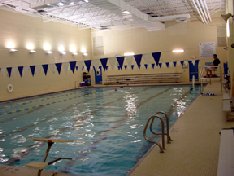The 42- by 75-foot pool's water would start a hot summer day at the desired setpoint of 84 degrees F, but water temperatures regularly climbed past 90 degrees. After ruling out other causes, it was determined that the water's temperature would rise because there was no air conditioning or modern mechanical dehumidification in the natatorium. In short, the pool water had turned into a heat sink for the surrounding air.
"It wasn't a real comfortable swimming experience on hot days," said Clark Lagemann, director of property and technology management, YMCA of Eastern Union County, Elizabeth, N.J.
The $500,000 budget was earmarked for a variety of improvements, including new lighting, electrical upgrades, a recoated pool surface, epoxy-painted walls and ceiling, plus the replacement of the chemical feeder, filter pump, motor, and strainer systems. The Y added HVAC improvements to the list.

System Design
The Y called upon Phil Nicholson, a sales/engineer for Stillwell-Hansen Inc., Edison, N.J., a local manufacturer's representative with expertise in natatorium IAQ. The mechanical contractor on the project was UniTemp Corp., South Plainfield, N.J., a wholly owned subsidiary of Pepco Building Services, Alexandria, Va.After seeing Rahway's need for space heating, air conditioning, and dehumidification as well as pool heating, Nicholson's design specified a packaged HVAC heat-recovering dehumidifier from Dectron Inc., Roswell, Ga., that would cover all IAQ needs in one unit. "To get the most for their money, they really needed one-stop shopping; a custom-manufactured heat-recovery dehumidifier would give them everything in one package with single-source responsibility," Nicholson said.
The natatorium's existing HVAC system consisted of makeup air handlers that circulated air and depended on exhausting and bringing in large quantities of outside air. It was adequate for ventilation, but exhausting and replacing a huge volume of air instead of reconditioning it isn't energy efficient by today's standards. Additionally, introducing hot, humid outside air without conditioning it in the summer only worsened the comfort concerns.
The heat-recovery dehumidifier (Dry-O-Tron Model RS-120) dehumidifies both room air and outdoor air, simultaneously conditioning them to either cool or heat the space.
As a bonus, energy recovered by the dehumidification process, plus the compressor heat, provides free pool water and space heating. A 512,000-Btu hot water boiler was installed as a backup for extremely cold days. The Y's existing 512,000-Btu boiler has been retained for a backup role to the building's water heating system. The combination of integral gas hot water heating and dehumidification are controlled and operated by the heat-recovery unit's Supervisaire® microprocessor.
Nicholson also specified a 9,500-cfm purge-mode exhaust fan that provides a quick air change in 10 minutes for the Y's routine super-chlorination pool water treatments.
Designing For Ductwork
Nicholson said he purposely specified the heat-recovery unit for the identical 11,000-cfm capacity of the previous HVAC air-handling units, then he calculated adjustments for static pressure. This allowed the retrofit to use the existing 65- by 24-inch rectangular stainless steel sheet metal ductwork trunk line and its branches, saving the project approximately $100,000 in stainless steel materials and installation labor."We were lucky there are no windows to condition, or we would have needed a larger dehumidifier and new ductwork," Nicholson stated.
Mechanical contractor UniTemp's structural engineering team examined the existing roof and determined that additional supports in truss webs were needed to support the rooftop's dehumidifier. According to project manager James Paslowski, stainless steel ductwork connecting the dehumidifier to the existing ductwork was custom fabricated by UniTemp and run through a loft section between the pool area and rooftop.
The HVAC retrofit is expected to provide a quick payback through energy savings. Besides economical benefits, the addition of air conditioning and dehumidification has helped improve attendance figures by enhancing the 6,230-square-foot natatorium's overall aesthetics, comfort, and indoor air quality.
Publication date: 08/29/2005



